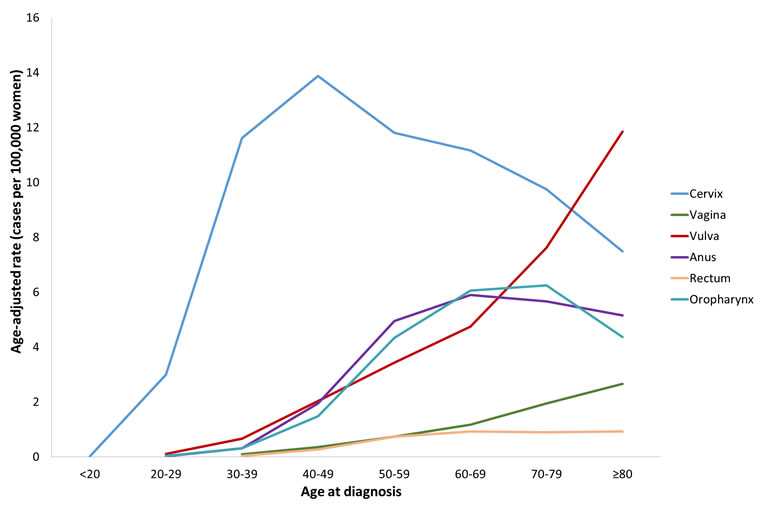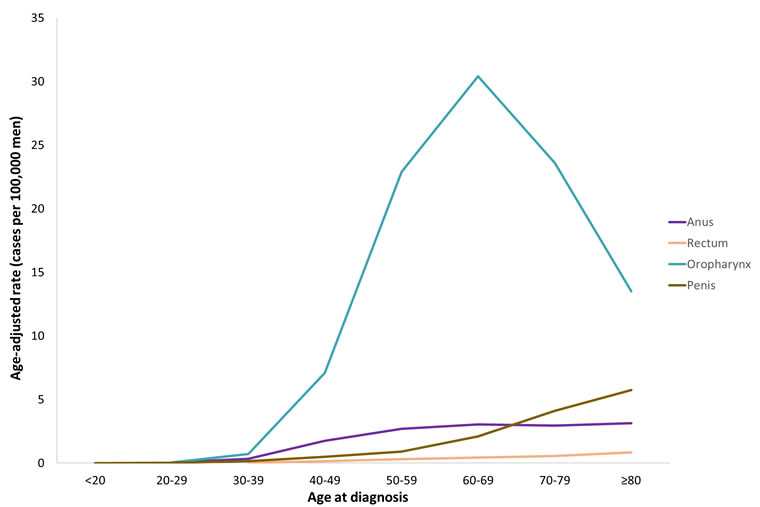HPV-Associated Cancer Diagnosis by Age
Cervical cancer is usually diagnosed at younger ages than other HPV-associated cancers. HPV-associated anal and oropharyngeal cancers generally are diagnosed at slightly younger ages in men than in women.
The median age at diagnosis (the age at which half of cancer patients were older and half were younger), is—
- 49 years for HPV-associated cervical cancer.
- 67 for HPV-associated vaginal cancer.
- 66 for HPV-associated vulvar cancer.
- 68 for HPV-associated penile cancer.
- 60 among women and 57 among men for HPV-associated anal cancer.
- 61 among women and 62 among men for HPV-associated rectal cancer.
- 62 among women and 59 among men for HPV-associated oropharyngeal cancers.
*Note: This study used cancer registry data to estimate the amount of HPV-associated cancer in the United States by examining cancer in parts of the body and cancer cell types that are more likely to be caused by HPV. Cancer registries do not collect data on the presence or absence of HPV in cancer tissue at the time of diagnosis. In general, HPV is thought to be responsible for about 91% of cervical cancers, 75% of vaginal cancers, 69% of vulvar cancers, 63% of penile cancers, 91% of anal cancers, and 70% of oropharyngeal cancers.
Rates of HPV-Associated Cancers and Age at Diagnosis Among Women in the United States, 2009–2013

The chart above shows rates by age group for HPV-associated cancers in the United States during 2009–2013. The rates shown are the number of women in each age group who were diagnosed with HPV-associated cancer for every 100,000 women. Rates were not shown for some cancer sites and age groups because there were fewer than 16 cases.
Rates of HPV-Associated Cancers and Age at Diagnosis Among Men in the United States, 2009–2013

The chart above shows rates by age group for HPV-associated cancers in the United States during 2009–2013. The rates shown are the number of men who were diagnosed with HPV-associated cancer for every 100,000 men. Rates are not shown for some cancer sites and age groups because there were fewer than 16 cases.
Data are from population-based cancer registries participating in the CDC National Program of Cancer Registries and/or the NCI Surveillance, Epidemiology and End Results Program, meeting criteria for high data quality for all years 2009–2013, and covering about 99% of the U.S. population.
Reference
Viens LJ, Henley SJ, Watson M, Markowitz LE, Thomas CC, Thompson TD, Razzaghi H, Saraiya M, Centers for Disease Control and Prevention (CDC). Human papillomavirus–associated cancers—United States, 2008–2012. MMWR 2016;65(26):661–666.
- Page last reviewed: March 6, 2017
- Page last updated: March 6, 2017
- Content source:


 ShareCompartir
ShareCompartir